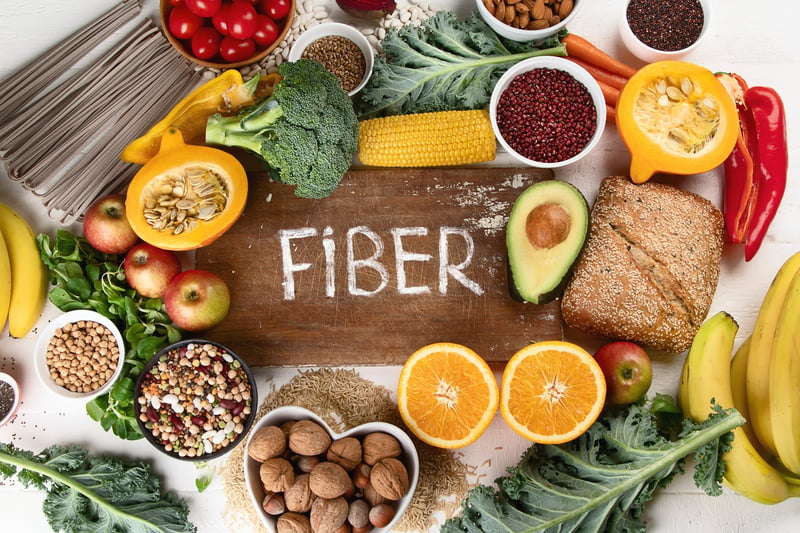95% of Americans Deal With Fiber Deficiency — Are You One of Them?

Do you suffer from bloating or constipation, energy spikes and crashes, excess hunger, brain fog, weight gain, high triglycerides, cholesterol and/or blood sugar, or skin breakouts? What do all of these symptoms have in common? They’re all signs of fiber deficiency. So, if you are experience some or most of them, you might be part of the 95% of Americans with a fiber deficiency.
Fiber isn’t just healthy, it’s essential. It keeps our digestive systems running smoothly and regularly; it helps us feel full and satisfied after meals; it supports normal blood sugar levels, healthy cholesterol levels, heart health, weight loss, and more; and it’s key to a flourishing gut microbiome. In other words, it’s good for our overall health and decreasing the risk of numerous diseases!
Why Are Most Americans Suffering From Fiber Deficiency?
When it comes to eating healthfully, most people put the focus on calories, sugar, and/or salt. And we ignore this powerful superfood—so much so that a mere 5% of folks in the U.S. meet the recommended target of 25 grams for women and 38 grams for men.
Around 75% of people rank their diets as “good,” “very good,” or “excellent,” according to an NPR/Truven Health Analytics poll. Says who!?! According to the Centers for Disease Control and Prevention, an astounding 90% of us don’t eat the recommended amounts of fruits and vegetables (2 to 3 cups of vegetables and 1 ½ to 2 cups of fruits per day).
So, even if you think you eat a healthy diet, chances are good (really, really good) that you are suffering from a fiber deficiency! And it’s worse for folks who are eating a traditional American diet—eating high amounts of processed and prepared foods over whole foods like vegetables, beans, fruits, and nuts and seeds.
Here’s why that’s important. Researchers reviewed 185 studies and 58 clinical trials and discovered that if 1,000 people went from eating a low-fiber diet (defined as under 15 grams per day) to a high-fiber diet (between 25 and 29 grams per day), 13 deaths and 6 cases of heart disease would be prevented.
Imagine the headlines we’d be reading if fiber were a drug—it would be considered a miracle pill!
Why Are Both Types of Fiber Important?
So, how can something the body doesn’t even digest or absorb be so important?
To answer that question, you have to look at the two types of fiber: soluble fiber, which dissolves in water, and insoluble fiber, which doesn’t.
Soluble fiber forms a gel-like material when dissolved in water and can help lower both cholesterol and blood sugar levels. It’s found in oats, barley, beans, peas, apples, carrots, and other plant foods.
Insoluble fiber, on the other hand, passes through the GI tract relatively intact and helps move waste materials through and out of the body. As such, it helps increase stool bulk to relieve constipation and make you more regular. It can be found in whole grains, beans, and vegetables like potatoes, cauliflower, and green beans.
Both types nourish our gut bacteria. Fermentable fibers, which includes all soluble fibers as well as some insoluble fibers, are metabolized by the microbiome, and this process creates nutrients that are not just important for the gut microbiome but for our overall health as well. For example, one of the by-products of gut microbial fermentation of certain fibers is short-chain fatty acids (SFCA), which promote insulin to better manage blood sugar spikes. SFCA may also help support the response to inflammation, and they also fuel the cells of the immune system.
With as fantastic as fiber is, people who suffer from excessive gas and bloating with high-fiber foods may need to consume a low FODMAP diet, which limits fermentable foods, including fibers that can aggravate bowel syndromes. Once the gut has a chance to repair, then fiber-rich foods may be slowly reintroduced.
Simple Tips to Combat Fiber Deficiency
Fiber has also been shown to increase the diversity of the microbiome, especially when we eat a variety of high-fiber foods. Foods to eat more of include:
- Fresh-cut vegetables and fruits (5+ servings per day)
- Beans and legumes
- Air-popped popcorn
- Whole grains like oatmeal, brown rice, and quinoa
- Nuts and seeds
- Cocoa powder
One simple way to increase fiber intake is to supercharge your morning smoothie. Along with your favorite protein powder and liquid of choice, throw in a handful of veggies like spinach or kale, some delicious fruit, and even some nuts, seeds (like chia or hemp), or beans. Yes, beans can be added to a smoothie and can add up to 10 grams of fiber per half cup.
It’s also important to ensure you’re drinking plenty of water with your fiber as fiber works better with water.
Don’t, however, increase your fiber intake too quickly. Take your time to add more fiber-rich foods into your diet. Otherwise, you may experience increased gas and bloating.
The next time you’re looking at a food label, look beyond the calories, proteins, carbs, and fats; take inventory of the fiber content. Instead of shooting for a magical number, start with “more” until you hit the recommended amount of up to 38 grams per day. The increased fiber won’t just help you stay regular and normalize bowel movements, it may help you achieve and maintain a healthy weight and an even live a longer, healthier life.






